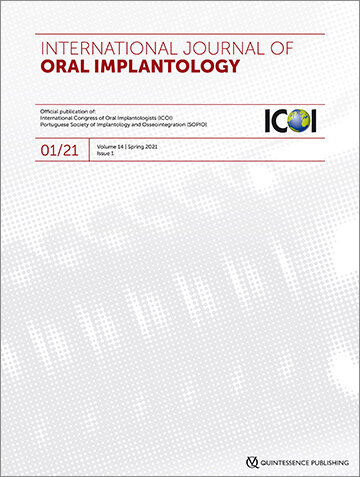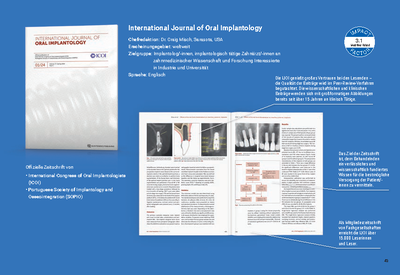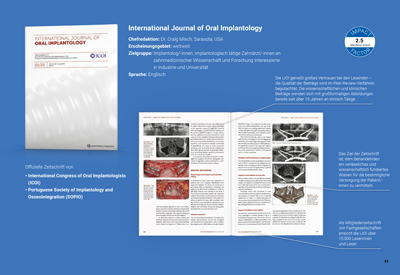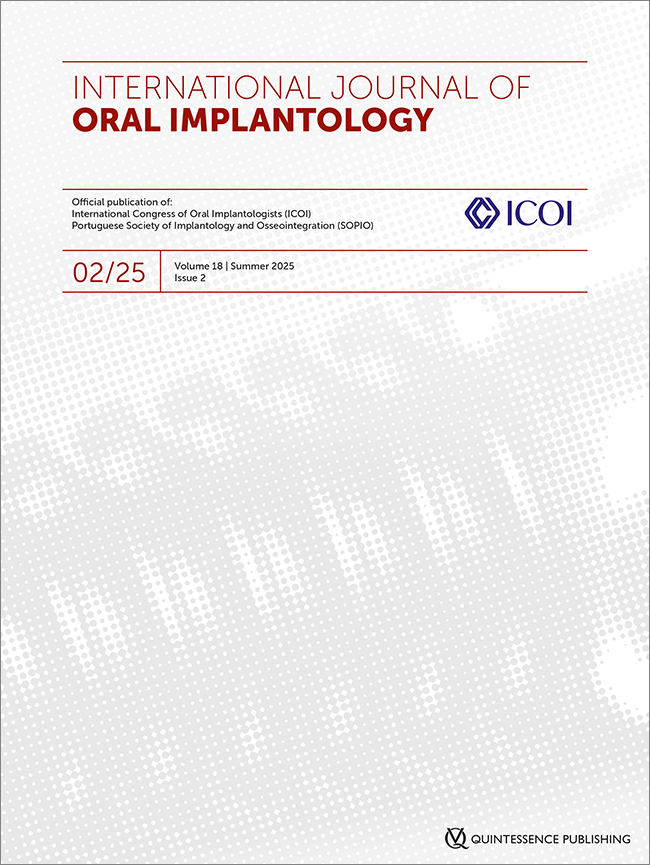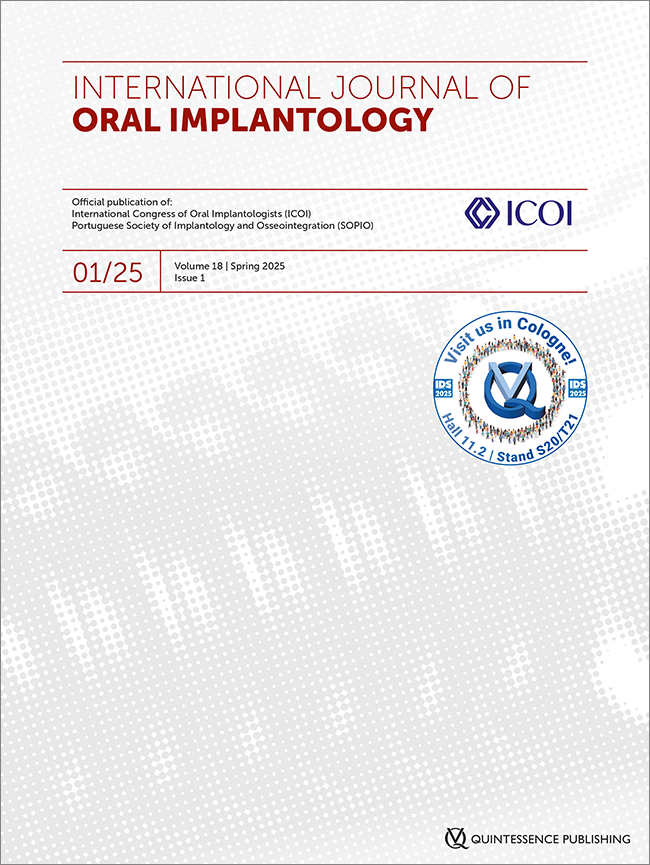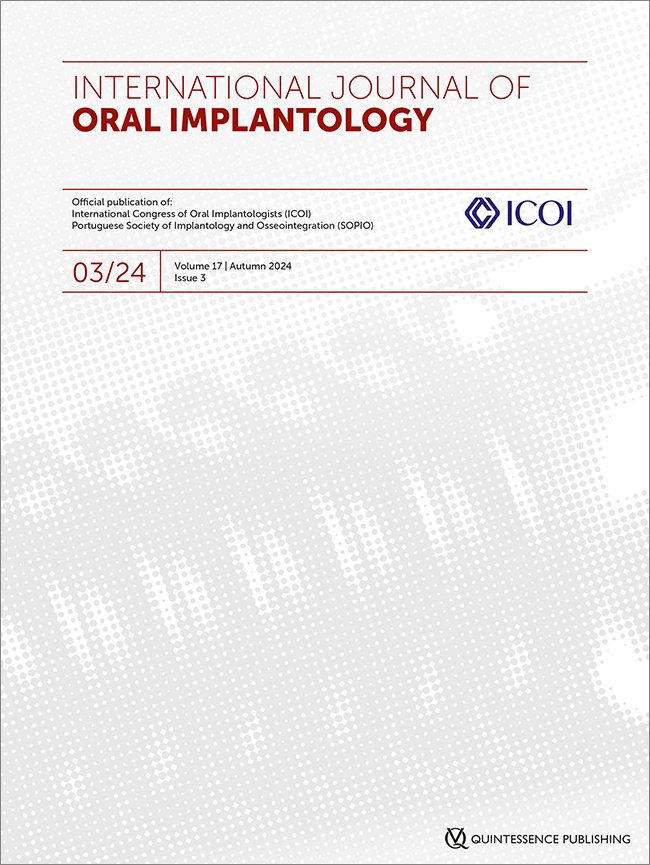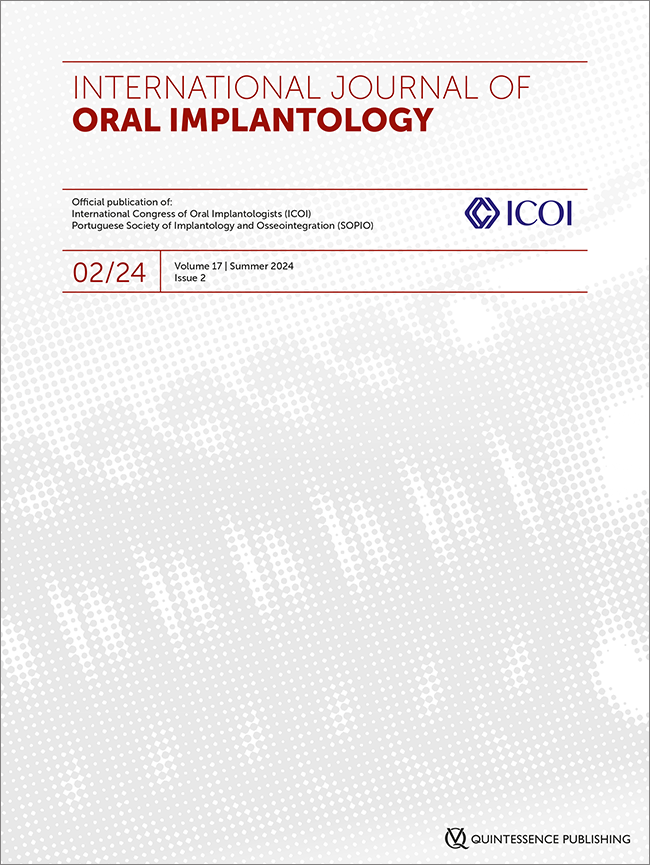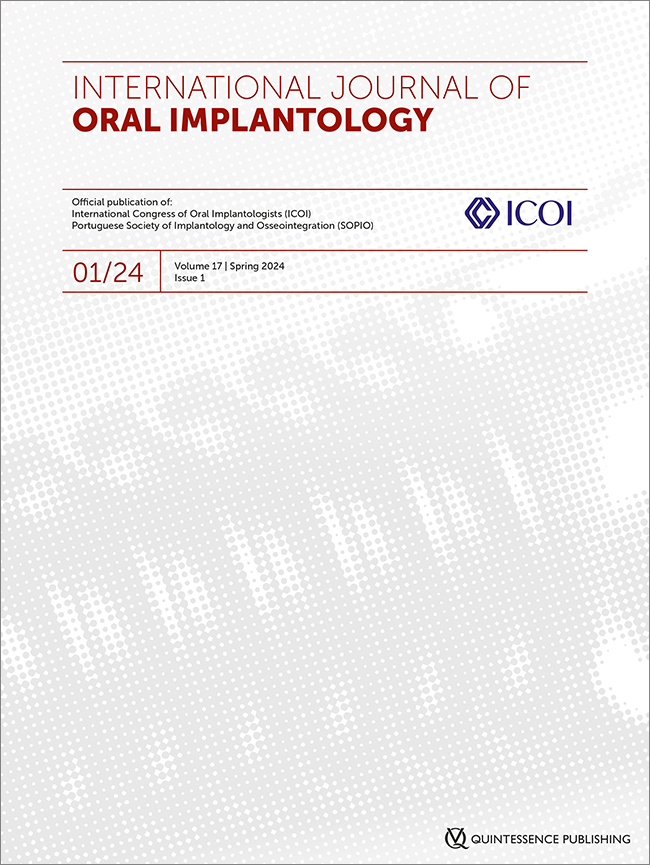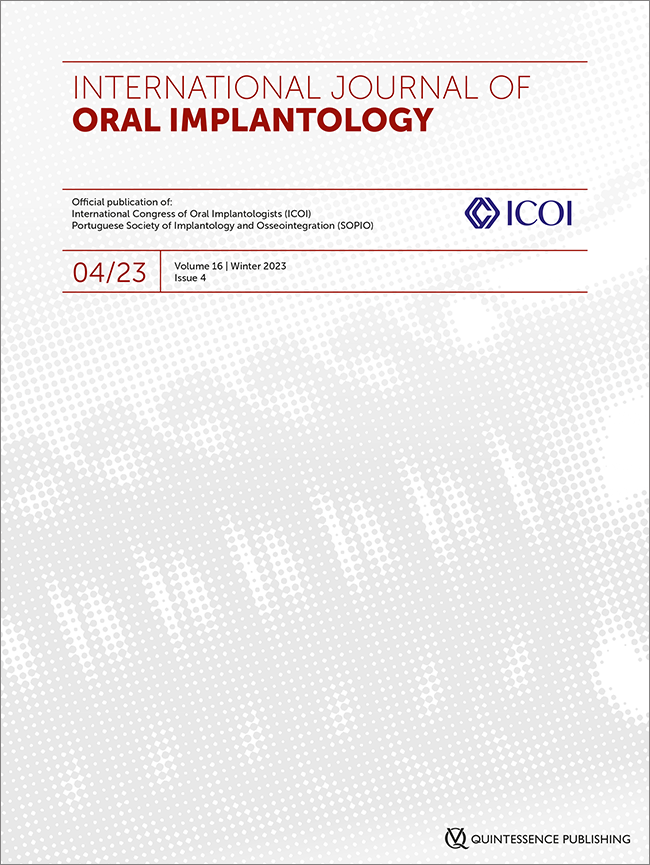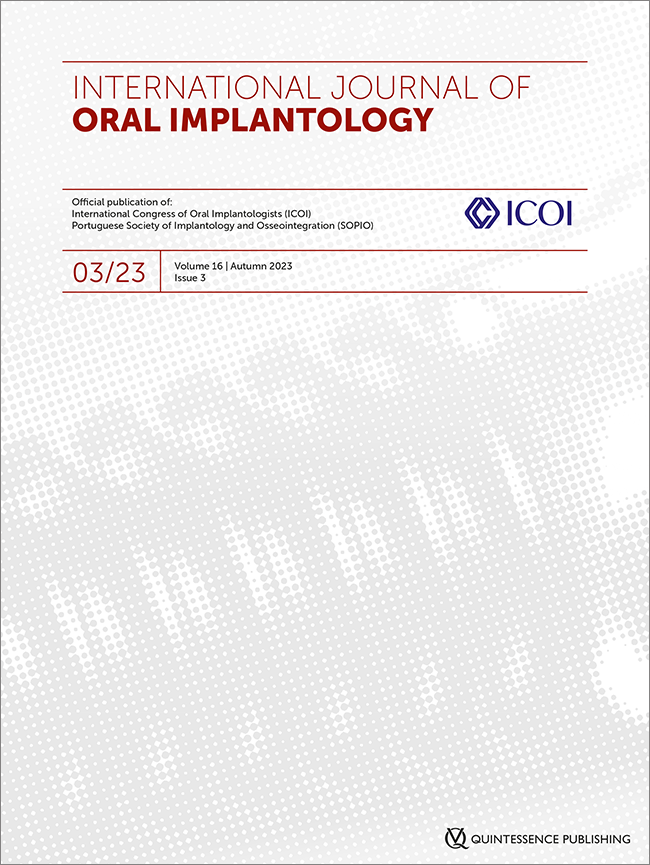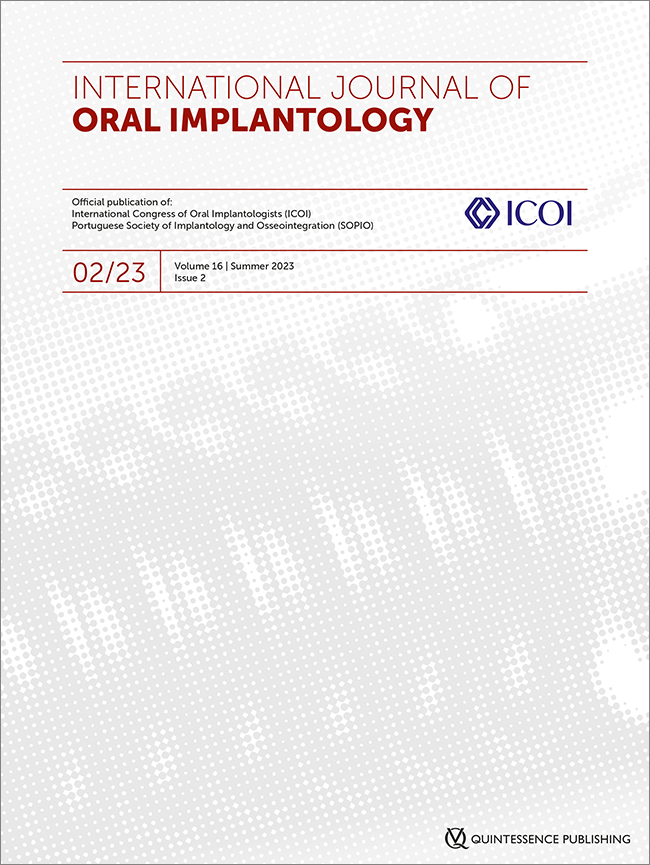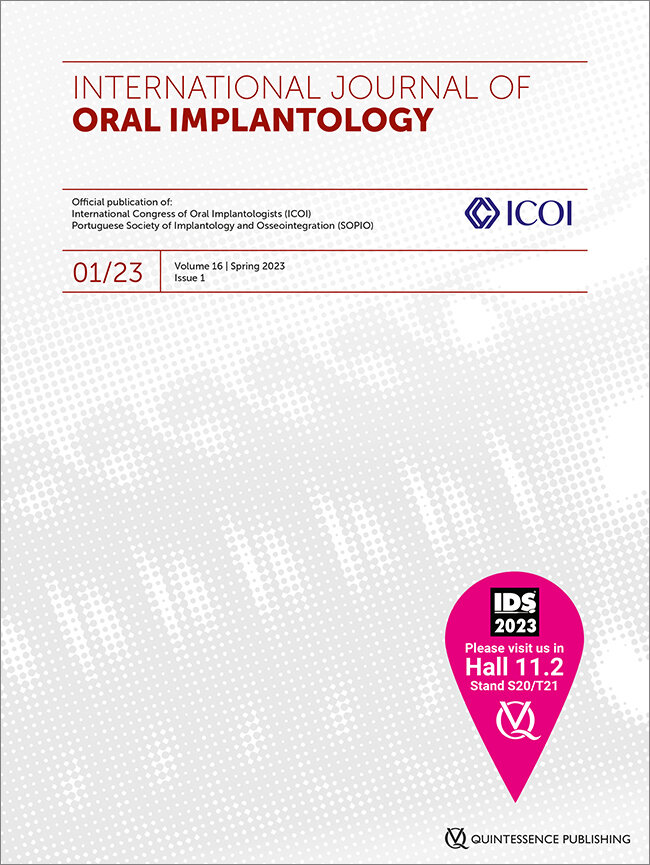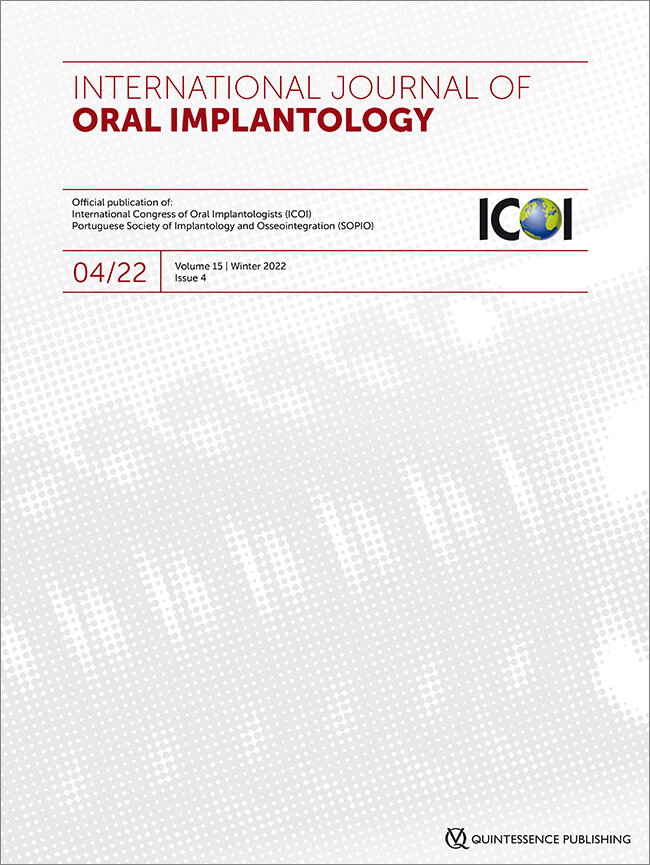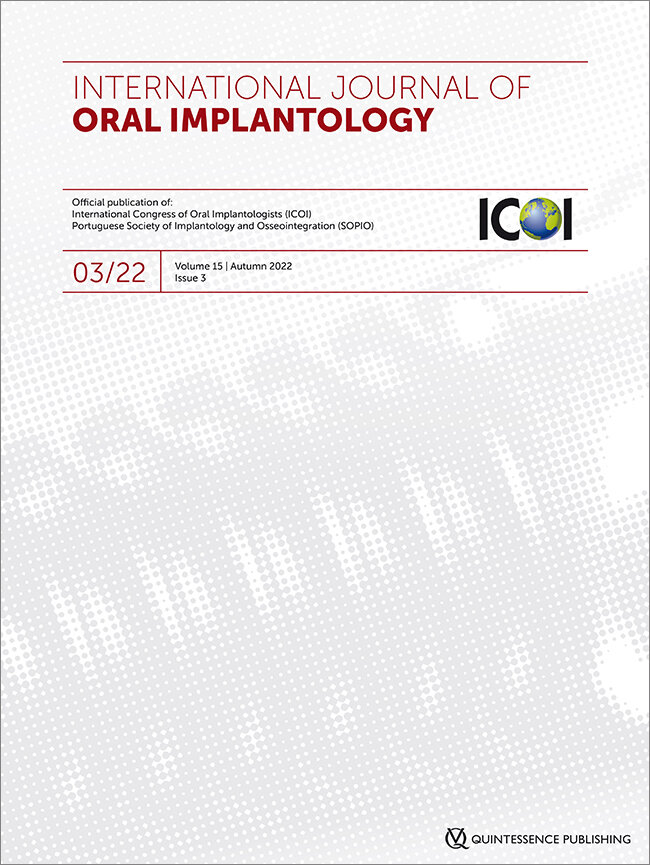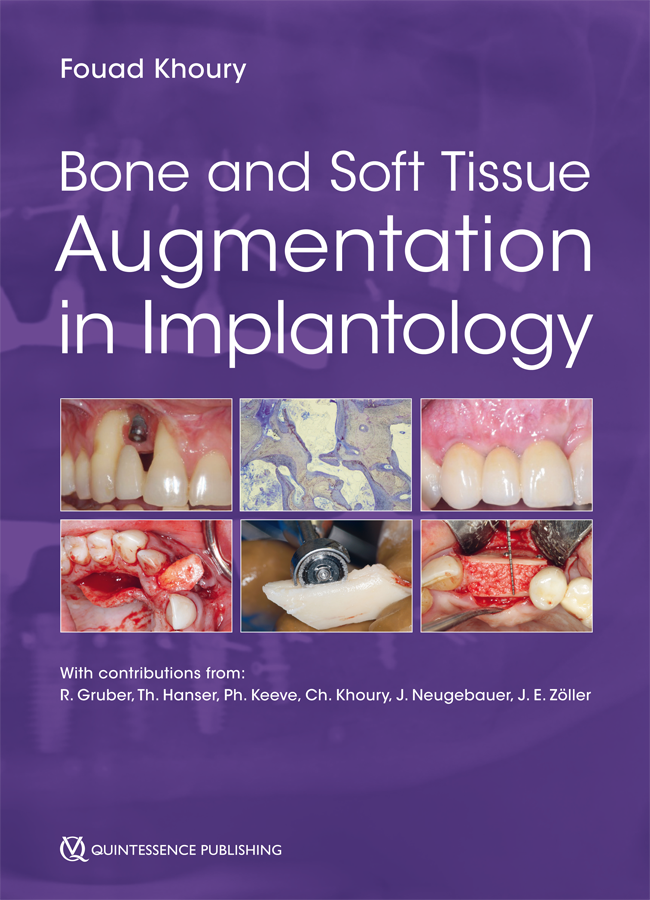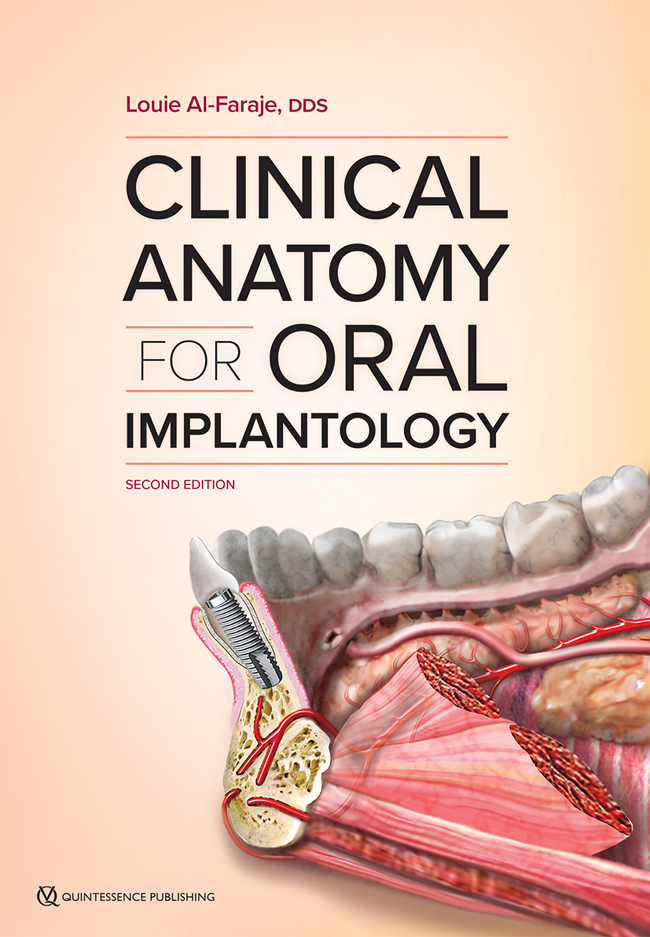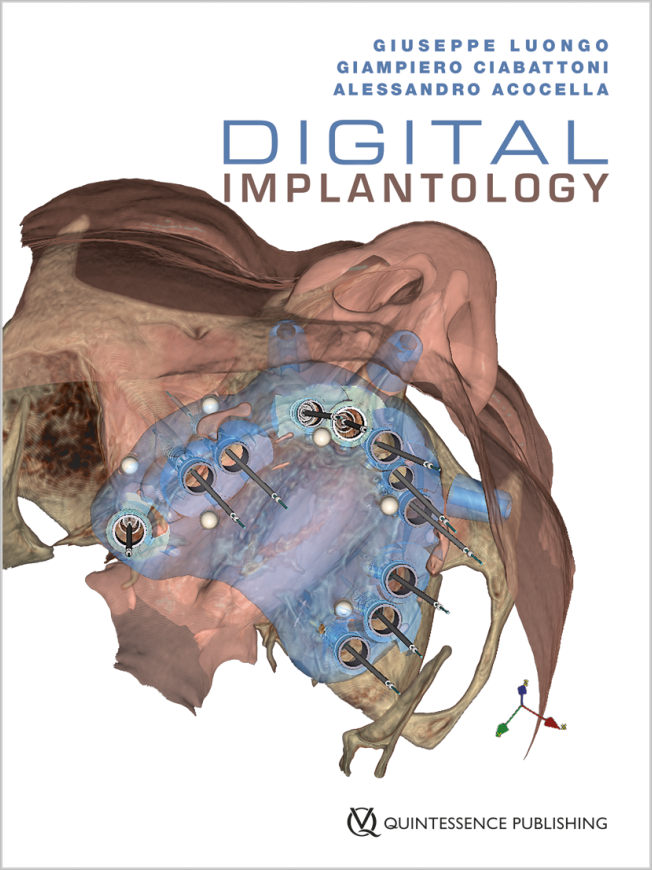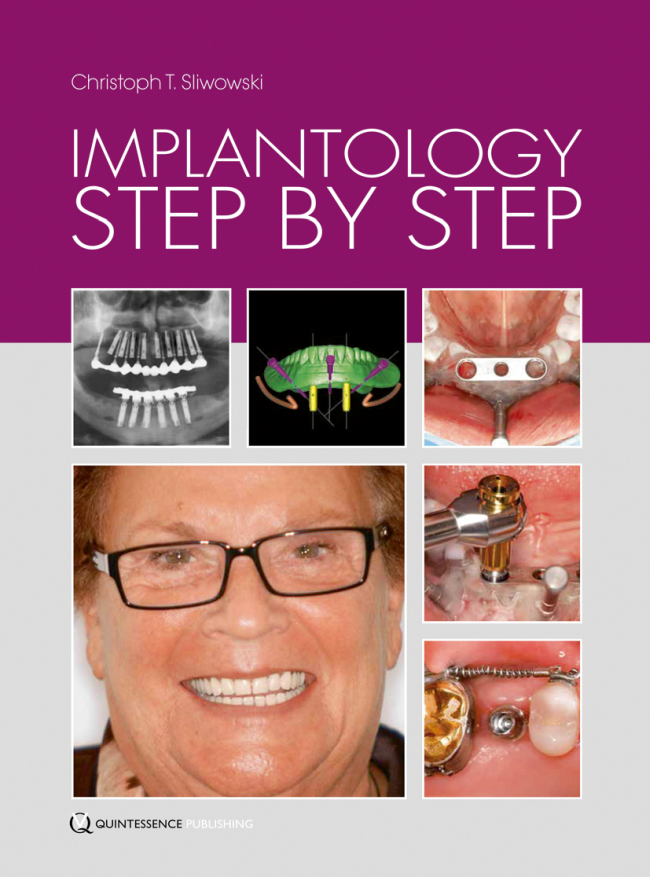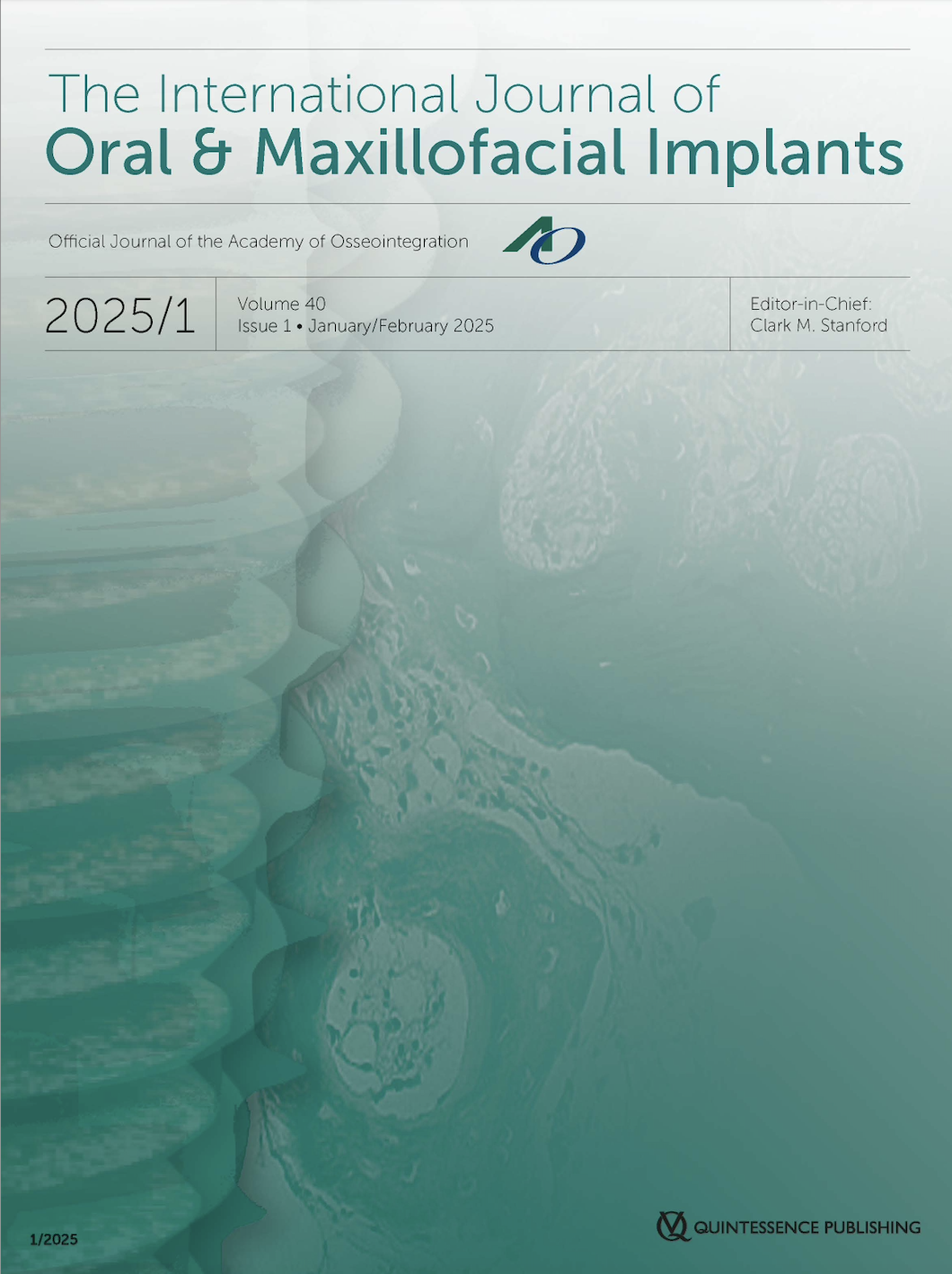Seiten: 95-96, Sprache: EnglischMisch, Craig MEditorialSeiten: 105-116, Sprache: EnglischGianfreda, Francesco / Antonacci, Donato / Mastrangelo, Filiberto / Raffone, Carlo / Mancini, Leonardo / Scarpati Cioffari di Castiglione, Maria / Caponio, Vito Carlo Alberto / Bollero, PatrizioPurpose: To evaluate the failure rate of trans-sinus implants for full-arch rehabilitation in atrophic maxillae, comparing their outcomes to those achieved with axial and tilted implants. Materials and methods: The review followed the Preferred Reporting Items for Systematic reviews and Meta-Analyses guidelines, including studies where patients underwent rehabilitation with trans-sinus implants alone or in combination with axial or zygomatic implants. The review was registered on the International Prospective Register of Systematic Reviews (ID: CRD42024537320). A meta-analysis using Haldane and hybrid corrections compared failure rates between implant types. Results: Out of 2,359 articles, 10 studies employing trans-sinus implants were selected. In the meta-analysis, the trans-sinus group was composed of 232 implants, 5 of which failed, compared to 5 of the 675 implants in the axial/tilted group. There were no statistically significant differences in failure rate between the groups (RRHaldane = 2.80, 95% confidence interval 0.89 to 8.77, P = 0.076; RRHybrid = 2.74, 95% confidence interval 0.91 to 8.17, P = 0.070). The pooled analysis indicated a comparable success rate. Conclusions: Trans-sinus implants represent a viable alternative, in terms of survival rate, to axial/tilted implants for rehabilitation of the atrophic maxilla, minimising the need for invasive procedures such as extensive bone grafting; however, further controlled clinical trials with longer follow-up periods are needed to confirm these results.
Schlagwörter: All-on-4, immediate loading, maxillary atrophy, prosthetic rehabilitation, trans-sinus implants
The authors declare there are no conflicts of interest relating to this study.
Seiten: 119-133, Sprache: EnglischTestori, Tiziano / Stacchi, Claudio / Felice, Pietro / Strappa, Enrico M / Gemelli, Charlotte / Clauser, Tommaso / Rapani, Antonio / Saleh, Muhammad H / Avila-Ortiz, Gustavo / Berton, Federico / Bornstein, Michael M / Botticelli, Daniele / Cha, Jae-Kook / Chan, Hsun-Liang / Farina, Roberto / Galindo-Moreno, Pablo / Jung, Ui-Won / Lim, Hyun-Chang / Lombardi, Teresa / Starch-Jensen, Thomas / Stavropoulos, Andreas / Taschieri, Silvio / Thoma, Daniel / Trombelli, Leonardo / Wallace, Stephen / Chiapasco, Matteo / Jensen, Ole T / Lozada, Jaime / Pikos, Michael A / Pistilli, Roberto / Urban, Istvan / Valentini, Pascal / Zuffetti, Francesco / Felisati, Giovanni / Saibene, Alberto / Craig, John R / Wang, Hom-LayPurpose: To achieve a consensus among international experts regarding the management of postoperative complications after maxillary sinus floor elevation. Materials and methods: A total of 32 experts were enrolled and divided into dental implant providers (21), experts with a well-established reputation as sinus specialists (8), ear, nose and throat specialists (2), and experts with a well-established reputation as ear, nose and throat specialists (1). Before starting, a systematic literature search was conducted on the topic, and a list of articles was sent to the panel. The development group formulated 20 statements, which were sent out in the form of a survey. After each round, the statements upon which a consensus was not reached were reformulated based on anonymous comments from participants. A total of three rounds were planned. Results: After the third round, a consensus was reached on 15 key statements regarding the management of postoperative complications following sinus floor elevation. Agreement was established on issues including common postoperative symptoms, use of radiographic assessments, the necessity of surgical interventions such as partial or total graft removal, and the potential need for functional endoscopic sinus surgery. Near-consensus was achieved on additional points concerning normal postoperative symptoms, timing of total graft removal and approaches to late graft infections. Conclusions: The present Delphi consensus suggests that postoperative symptoms such as pain and swelling are generally manageable with appropriate pharmacological treatment. It also outlines conditions where radiographic evaluation is recommended for further assessment. Surgical options, including partial or total graft removal and functional endoscopic sinus surgery, are recommended based on the clinical scenario and response to initial treatments. Variability in practices, particularly regarding antibiotic use and specific intervention timing, suggests a need for further research to be conducted in order to standardise treatment protocols and address gaps in evidence.
Schlagwörter: consensus, maxillary sinusitis, peri-implantitis, sinus floor augmentation
The authors declare there are no conflicts of interest relating to this study.
Seiten: 135-144, Sprache: EnglischGiulini, Mika / Kassem, Nizar / Schwarz, Frank / Weigl, Paul / Schwiertz, Andreas / Sader, Robert / Lorenz, JonasPurpose: Ceramic implants are gradually becoming an alternative to standard titanium implants; however, there is still a lack of scientific data on the former. Thus, the present study was conducted to assess the clinical and microbiological performance of a two-piece ceramic implant system after a mean follow-up period of 2 years. Materials and methods: A total of 17 patients from a collective of 21 from a private dental practice that met the inclusion criteria received 32 two-piece ceramic implants (CERALOG, BioHorizons Camlog, Basel, Switzerland). The implants were restored with single crowns or three-unit fixed partial dentures. Implant survival, probing pocket depth, bleeding on probing, mucosal recession/creeping, keratinised mucosa width, Papilla Presence Index, peri-implant marginal bone level and microbiological contamination were evaluated after a mean loading period of 24 months (range 12 to 41 months). Results: All implants survived and were suitable for retaining prostheses. Probing pocket depth of 3.7 mm ± 0.7 mm and bleeding on probing on 84% of implants were recorded. Sufficient keratinised mucosa width (6.6 ± 2.9 mm) was observed with no mucosal recession/creeping. The Papilla Presence Index varied between 0 and 4 with a mean value of 1.70 ± 1.07. Mean marginal bone loss was 1.2 ± 0.9 mm. Microbiological investigation revealed no statistically significant difference in the total number of bacteria between teeth and implants (P = 0.2278); however, probing pocket depth > 4 mm proved to be a significant predictor for an increased number of bacteria (P 0.001). Conclusion: Within the limitations of the present study, the investigated two-piece ceramic implant system achieved fully satisfying functional and microbiological results. Interpretation of the clinical, radiographic and microbiological results cannot support the hypothesis that ceramic implants are less affected by peri-implant disease.
Schlagwörter: ceramic implants, microbiological test, two-piece ceramic implants, zirconia implants
The authors declare there are no conflicts of interest relating to this study.
Seiten: 147-157, Sprache: EnglischGibello, Umberto / Lanzetti, Jacopo / Crupi, Armando / Longhi, Beatrice / Molinero-Mourelle, Pedro / Roccuzzo, Andrea / Pera, FrancescoPurpose: To evaluate the clinical outcomes and prosthetic complications in patients rehabilitated with full-arch fixed implant-supported prostheses according to the Columbus Bridge Protocol who did not adhere to a structured supportive peri-implant care programme. Materials and methods: This cross-sectional study included 56 patients (mean age 67.8 ± 9.2 years; 28.6% smokers; 80% response rate) rehabilitated with 229 implants (implant survival rate 100%) according to the Columbus Bridge Protocol. Patients were divided into three groups based on follow-up duration: 1 to 2 years (n = 19), 3 to 6 years (n = 16) and > 6 years (n = 21). Through a comprehensive examination, clinical parameters (probing depth, plaque index, bleeding on probing and keratinised tissue width) and mechanical and technical complications were examined by a single experienced operator. Plaque accumulation on the prosthesis was assessed through clinical images using a plaque disclosing solution and ImageJ software (National Institutes of Health, Bethesda, MD, USA). Finally, patient satisfaction was assessed using the Oral Health Impact Profile-14 scale. Results: Mean probing depth values remained stable across groups (2.03 to 2.49 mm, P = 0.125), with most sites ≤ 3 mm. No significant differences were found for bleeding on probing among groups (14.8% to 23.1%, P = 0.331). Plaque levels were high both at implant (43.8% to 57.1%, P = 0.233) and prosthesis level (42.9% to 47.0%, P = 0.707), with no significant differences between groups (P > 0.05). Keratinised tissue width ranged from 3.05 to 3.49 mm (P = 0.650). Prosthetic complications showed an increasing trend as follow-up duration increased (5.3% at 1 to 2 years, 18.8% at 3 to 6 years and 33.3% at > 6 years) (P = 0.086). Overall Oral Health Impact Profile-14 scores indicated a high level of patient satisfaction. Conclusions: Despite the lack of adhesion to a supportive peri-implant care programme, reflected by the high plaque values at implant and prothesis level, the Columbus Bridge Protocol resulted in positive clinical outcomes; however, prosthetic complications occurred and increased over time.
Schlagwörter: full-arch implant-supported prosthesis, implant disease prevention, mechanical and technical complications, oral hygiene maintenance, supportive peri-implant care
The authors declare there are no conflicts of interest relating to this study.
Seiten: 159-168, Sprache: EnglischDavido, Nicolas / Boutin, Nicolas / Cannas, Bernard / Davido, BenjaminIntroduction: Autogenous bone grafting in oral surgery poses significant challenges, particularly in maintaining long-term bone stability. Osteoimmunology, which emphasises the role played by the immune system in bone formation and resorption, has gained attention for improving graft success rates. Azithromycin, a macrolide antibiotic, exhibits immunomodulatory properties, whereas platelet-rich fibrin contains growth factors that promote bone healing. Methods: The present retrospective study analysed 275 patients treated between 2014 and 2023 at a primary care centre in Paris, France. The inclusion criteria required patients to be aged over 18 years and to have undergone autogenous bone grafting using the split bone block technique. Three antibiotic regimens were compared: the standard of care, standard of care combined with platelet-rich fibrin, and standard of care combined with platelet-rich fibrin and azithromycin. The primary outcome was the occurrence of bone resorption or locoregional complications within a 4-month follow-up period. Results: The overall success rate was 75.3%, with major bone resorption observed in 24.7% of cases. Multivariate analysis identified penicillin allergy (P 0.01) and posterior bone defects (maxilla and mandible, P = 0.02 and P = 0.001, respectively), as predictors significantly associated with higher failure rates. In contrast, the combination of platelet-rich fibrin and azithromycin improved outcomes significantly (adjusted odds ratio 8.38, P 0.001). Conclusion: The combination of platelet-rich fibrin and azithromycin markedly enhanced the success of autogenous bone grafts, likely due to the immunomodulatory effects of azithromycin on the receptor activator of nuclear factor NF-κB ligand pathway. These findings support further investigation into this approach, particularly guided bone regeneration.
Schlagwörter: autogenous bone grafting, azithromycin, platelet-rich fibrin
The authors declare there are no conflicts of interest relating to this study.
Seiten: 169-179, Sprache: EnglischMancini, Leonardo / Tavelli, Lorenzo / Barootchi, Shayan / Jung, Ronald E / Thoma, Daniel SPurpose: To utilise high-frequency ultrasound echo intensity as a method for identifying a safe harvesting zone and assessing tissue thickness, density and vascularisation in the palatal region for soft tissue harvesting. Materials and methods: Four consecutive patients requiring soft tissue augmentation were recruited. Optical scans were taken and imported into design software, where customised guides were developed based on the patient’s palatal anatomy and the harvesting zone. The guides were tailored to fit the shape of the ultrasound probe. They were 3D printed and allowed for a standardised examination of the palate, the identification of a safe harvesting zone and the evaluation of tissue thickness, quality and vascularisation using high-frequency ultrasound. Following these steps and using an echo-harvesting guide, a de-epithelialised free gingival graft was obtained, ensuring preservation of the main vascular flow while avoiding fatty or glandular tissues. Results: In all four cases, high-frequency ultrasound scans were successfully obtained and the mean measured soft tissue thickness increased from 3.2 mm (anterior) to 6.0 mm (posterior), with a mean transversal increase from 0.9 to 6.0 mm. Ultrasound imaging revealed a layer of hypoechogenic fatty/glandular tissue located 3 to 4 mm beneath the epithelial layer. Using colour Doppler analysis, the vascular flow was identified and mapped to help design a safe harvesting zone. The tissue density, evaluated using a grayscale analysis, showed hypoechogenicity corresponding to fatty/glandular tissues and areas with blood vessels, whereas dense connective tissue appeared isoechoic. This differentiation allowed for precise localisation of the safe harvesting zone, an optimal zone for connective tissue harvesting, while ensuring that regions with higher fat/glandular content and/or large vascular structures were avoided. Conclusion: The echo-guided harvesting approach is a promising technique for soft tissue palatal harvesting, enabling clinicians to identify a standardised safe zone away from major blood vessels when assessing tissue quality and quantity. This approach enhances surgical precision and control, and facilitates preoperative planning for alternative treatments when graft size or tissue quality or quantity are inadequate due to proximity to the greater palatine artery. It is crucial to note that a learning curve is required to interpret the obtained images accurately and integrate this tool into daily clinical practice.
Schlagwörter: connective tissue graft, de-epithelialised gingival graft, soft tissue augmentation, soft tissue harvesting, ultrasonography
The authors declare there are no conflicts of interest relating to this study.
Seiten: 181-183, Sprache: EnglischMisch, Jonathan / Alrmali, Abdusalam E / Galindo-Fernandez, Pablo / Saleh, Muhammad H A / Wang, Hom-LayThe following amendments are made to the published article: Int J Oral Implantol 2025;18(1):73–84; First published 17 March 2025




